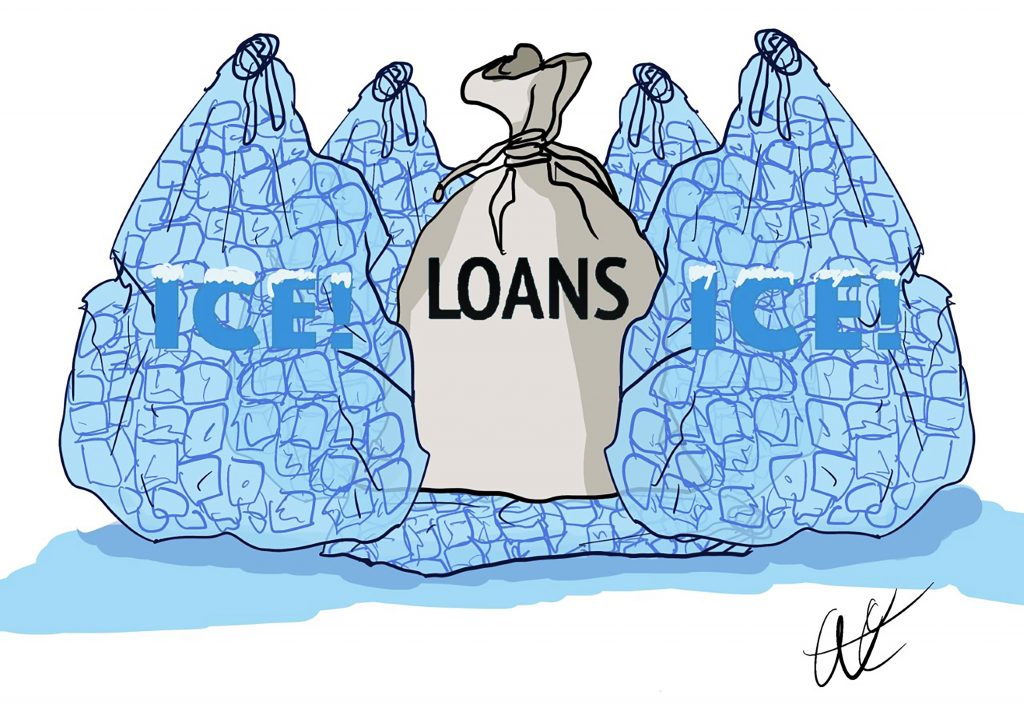OPINION: Federal loan repayments remain on ice, Biden loan forgiveness plan unreliable

By Alejandro Carbajal
Bridge Illustrator
Published Wednesday, May 18, 2022
Once again, federal student loan repayments and interest are frozen up until Aug. 31, as announced by Biden’s administration. Though it benefits the average individual, providing relief from repayment, the negatives fall upon the government and economy, which must bear the financial burden.
Biden loan forgiveness plan unreliable
By David Gomez Jr.
Editor-in-chief
Published Wednesday, May 18, 2022
About 43.4 million people hold federal student loans, according to the studentaid.gov website. Let’s let that sink in for just a moment.
About 92% of most loans, according to a July 2021 report by academic data firm Measure One, remain with the U.S. Department of Education.
President Joe Biden offered a plan to help 3.5 million people get out of that debt, or at least some relief.
Sen. Elizabeth Warren, D-N.H., and Sen. Bernie Sanders, D-Vt., voiced for canceling student debt. Biden needed support in his campaign and took on student loan discussions. Now in office, he committed to work with Congress to come up with a solution for student loans.
Biden wasn’t as passionate, or forthcoming as his other candidates who pushed for wiping out student loans all-together or at least canceling a majority of the borrowers’ federal loan debts.
Sure, there’s hesitancy on even blanketing student loan debt because even if the Executive Branch went through it with the stroke of a pen, it can be taken to court and end up not even falling through.
Currently, there are not enough Democratic Party members to pass the bill.
The other issue is that of self-responsibility, which most Republican Party members argue to avoid ruling over the blanketing of student loan debt.
The argument of “Well, I paid off my debt. Why can’t you?” made by those whose college credit hours were significantly cheaper. And how it should not be the responsibility of the taxpayers to pay for these individual loans.
According to the educationdata.org website, the average 2022 cost of tuition per credit hour in a U.S. public four-year institution is $390, which means that most college courses–at the most typical three credit hours–cost about $1,170, not counting room and board. Private colleges cost an average of $1,365 per credit hour, or $4,095 per course. By comparison, Texas A&M International University is currently $593.14 per credit hour, or $1,220.33 per course, including fees, for Texas residents or non-residents with a waiver.
“Factoring in student loan interest and the cost of lost income, the ultimate cost of the average bachelor’s degree exceeds $2,132 per credit hour, or $6,397 per course,” according to educationdata.org’s Cost of College Class or Credit Hour report from March 31.
According to the National Center for Education Statistics on nces.ed.gov, the cost of in-state tuition and required fees at four-year institutions was $20,492 in 2006-’07, $15,470 in 2000-’01, $10,294 in 1992-’93, $4,632 in 1982-’83, and only $2,534 in 1976-’77.
Most of the people in Congress earned their degrees when education costs were significantly lower and easier to pay off.
There’s a game show about student debt called Paid Off on TruTv. They ask educational questions about students’ own majors. Obviously, if they get them right, they get their student loan debt–Paid Off.
Also, Biden’s new student loan plan is actually an old one.
According to a Forbes online article, Income Driven Repayment programs allow some borrowers to repay their loans based on their income, and remaining in the program can ultimately result in student loan forgiveness after 20 or 25 years, depending on the plan. Some of these plans are for people in public service jobs, such as state and federal employment. The Department of Education automatically adjusts the number of qualifying payments a borrower has toward loan forgiveness, and officials indicated borrowers who were in repayment for 20 or 25 years may see automatic student loan forgiveness.
There is a problem with this approach. During the Clinton Administration in the ‘90s, a similar, if not same, plan only paid off student debt for 157 borrowers, according to the Government Accountability Office last June. Out of the millions who signed up–only 157.
At this point, I don’t think anyone should expect any student loan forgiveness to do what it is supposed to do, but rather go into school with the mindset they may owe more money than what they can possibly make once they have a bachelor’s degree.
Searching for a school that offers an accredited degree at an affordable price is what I believe to be the better alternative. Unless the individual can’t afford to leave their city, then please be cautious and pass those classes, because right now, nothing is set in stone. The sooner you can graduate, the less the debt. Biden’s plan is just a reminder that some of these programs are unreliable and that going to college, to better one’s life, is a fleeting American dream.
